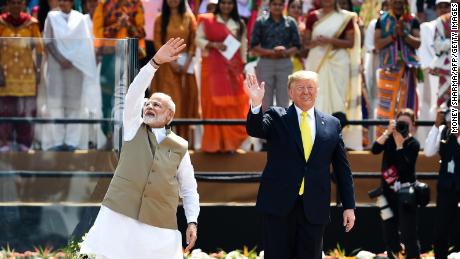
by Manoj Kumar 27 February 2020
The glamorous and high profile visit has impressed the people not only in India but abroad also, but once the visit is culminated policy makers of both the nations will be busy in analyzing the outcome of the visit. The kind of public display of magnanimous welcome in Ahemdabad has its own significance for influencing Indian community at a time when elections for US president is only months away. The Indian American population is the second-largest immigrant group in the country after Mexicans. The US is also home to the second largest Indian Diaspora globally. Indian Americans are the wealthiest (with household incomes almost double of the American average), most educated and law-abiding ethnic community in the US. The American Indians are evenly distributed in whole mainland of US in addition to it they are important factor in political funding and forming public opinion both in context of US and India. Indian community has been largely instrumental in forming favorable public opinion during Kargil conflict, nuclear tests, etc., and even has exercised their influence in legislation by US Congress. The kind of huge public gathering in Ahemdabad will be helpful in image building for both the leaders in their own country and abroad.
Donald Trump visit was contemplating to achieve mutual understanding and expectations from India to relax its trade restrictions on items related to agricultural produce. With both countries India and US are worried about global recession but even more serious is the threat of falling domestic demand. But amidst all the warmth related to visit no agreement has been reached on trade deal. A trade deal was always going to be tough given the two countries were engaged in a bitter tariff war just last year. Mr Trump would have loved to sign a deal that would help bridge the US $25.2bn (£19.3bn) trade deficit with India. US also expects India to open its market to high end technological goods, the demand for such kind of manufactured items are either has been stable or falling in US. To keep the demand alive and industry for such high end technology goods India can prove a significant market. On the other hand India will strongly like to associate itself as manufacturing base for US multinationals with linking it with ‘Make in India’. India is very much eager to compete with countries like China and Vietnam as manufacturing economies so that its large skilled manpower can be gainfully employed in such industries. Multinational companies also must have learnt some lesson from outbreak of ‘Corona Virus’ in China which has impacted the supply and value chain across the globe. The companies in future will like to diversify its manufacturing bases to different geographical regions so that affect of such ‘force majeure’ factors can be minimized.
In his speech at Motera Stadium in Ahemdabad the President of US expressed plan to fight against terrorism with India, which is in interest of India also. US is in process of reducing its troops in Afghanistan with reaching some kind of deal with Taliban. These developments are being closely watched by India as any increase in influence of fundamentalist elements in Afghanistan will have implications for Indian security and strategic interests. In the last two decades India has played as ‘soft power’ in Afghanistan by helping the country in rebuilding its infrastructure through building dams, parliament building and roads. India is helping Afghanistan in connecting it with Chabahar port in Iran and India further plans to connect plans it to Central Asian countries which will be used as energy corridors for both India and Iran. India regards Afghanistan as vital in its security calculus. First, India aims to foil the emergence of any brand of radical regime in Afghanistan. Moreover, India looks to limit Pakistan’s influence and aspires to keep its newly acquired strategic mileage in Afghanistan. Chiefly, India’s main concern is that no regime emerges in Afghanistan that is fundamentally hostile towards India.
US has very cautiously avoided to give strong opinion of issues like Citizen Amendment Act (CAA) and Kashmir and even lauded India for its secular values, noticeably termed CAA as an internal issue of India which clearly a significant indication of strong support of US to present Indian establishment.
With China as a strong disruptive factor in international order, US considers India as a stabilizing actor. The US President without naming any country has expressed serious security threat from actors like Huawei 5G technology. As per Michael Kugelman Deputy Director at The Wilson Centre, “China really looms large in this relationship. You can talk about shared values, the Modi-Trump friendship, but it’s really the converging interests that bring the two countries together,” he says. “Both countries see China as a concern”.
Both the countries US and India see themselves as important actors in changed global matrix especially in Indian Ocean region. Although apart from some important deals like supply of military hardware there was no agreement on ‘trade deal’, still the visit may be considered watershed in South Asian and global strategic and economic context.
